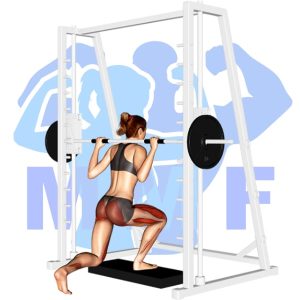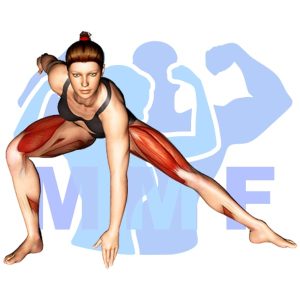Have you ever performed a stationary lunge and felt like you weren’t getting the full benefits of the exercise? Maybe you struggle with maintaining proper form or feel like you aren’t seeing results fast enough. Don’t worry, you’re not alone. Many individuals struggle with this exercise due to weak glutes or tight hip flexors. However, with a few simple modifications and techniques, you can take your stationary lunges to the next level. In this post, we’ll go over the common mistakes during stationary lunges, the reasons behind them, and the proper form and modifications to ensure you get the results you’re looking for.
Stationary Lunges Summary
- Primary Muscles: Gluteus Maximus
- Secondary Muscles: Adductor Magnus, Quadriceps, and Soleus
- Equipment: Body Weight
- Mechanics Type: Compound
- Force: Push
- Utility: Auxiliary

Stationary Lunges Instructions
- Stand with your hands on hips.
- Step out with one foot at the one and a half the length of your normal walking step.
- Lunge down by bending your hip and knee of your front leg.
- Allow the kneed to bend on your back leg and your heel o rise.
- Lunge as low as you feel comfortable, but stop before your back knee touches the ground.
- Press until both legs are fully extended, but don’t lift your feet off the ground.
- Repeat your these lunges for a set of 8-12 and then switch your legs for another equal set.
Video Tutorial
Stationary Lunges Muscles
Target (Agonist)
Synergists
- Adductor Magnus
- Quadriceps
- Soleus
Dynamic Stabilizers
Stabilizers
- Iliocastalis lumborum
- Iliocastalis thoracis
Antagonist Stabilizers
- None

Benefits of Stationary Lunges
Performing stationary lunges in a strength training or fitness routine can be a great way to target the gluteus maximus. This exercise can help strengthen and tone the largest muscle in the body, which is responsible for hip extension, thigh abduction, and external rotation of the femur. Additionally, stationary lunges can help increase your range of motion in the hips, thighs, and knees, as well as reduce risk of injury to these areas. The strengthening of the gluteus maximus also helps improve posture and balance, which can be beneficial for everyday activities.
Tips for Performing Stationary Lunges
You’ve landed at the right location if you desire to advance your capability to perform stationary lunges. These tips can enable you to benefit fully from this wonderful workout and maximize its effects. Concurrently with shaping your glutes muscles, improving movability, and also a reduced possibility of injury can all be accomplished with this exercise. Let’s begin and take a look at how these suggestions will benefit you.
- Engage your core: Maintaining good form is essential for getting the most out of the stationary lunge exercise. By engaging your core muscles you can ensure that you are properly balanced and keep your posture strong throughout the entire movement.
- Keep your back straight: It is important to keep your back straight while doing the stationary lunge, as this will help to prevent any injury and also ensure that you are getting the full benefit from the exercise.
- Focus on form: It’s easy to rush through an exercise, but when it comes to stationary lunges it’s important to focus on form. Make sure that your knee is tracking over your toes and that you are not allowing it to travel too far forward or backward. This will help you get the most out of the exercise and prevent any injuries.
Benefits and Tips Video
Frequent Mistakes To Avoid
Staying away from errors can be the distinction between a productive training session and an injury when performing stationary lunges. Additionally, achieving the most out of the exercise requires proper technique, and avoiding make any typical errors can allow you to perform the exercise correctly and obtain optimal results. Don’t worry, though, it’s not nearly as hard as it might appear. You can execute the exercise safely and efficiently by avoiding the mistakes to prevent and by following the correct steps. Thus, it is now your turn to maximize your results from this exercise and experience the advantages of a productive workout.
- Not engaging the core: When performing stationary lunges, it is important to engage the core muscles and ensure proper form. This will help keep your body in balance and reduce the risk of injury.
- Not going low enough: When performing stationary lunges, it is important to make sure that you go down as low as you can, so that you get the full range of motion and engage all of the muscles necessary to maximize your workout.
- Not controlling the movement: When performing stationary lunges, it is important to control the movement and not just ‘lunge’ without any control or thought. Controlling the movement will help ensure proper form and maximize the benefits of your workout.
Find More Bodyweight Exercises Here
Variations and Complementary Exercises
If you are looking for ways to change up your workout routine, here are some variations, complementary, or alternative exercises for the exercise Stationary Lunges. These exercises work similar muscles as the exercise Stationary Lunges and can help you build strength and endurance.
Smith Machine Single Leg Deadlift

The Smith Machine Single Leg Deadlift is a great complementary or alternative exercise for the Stationary Lunge. It targets the same muscles as the Stationary Lunge—the glutes, hamstrings, and calves—but the movement pattern is different. The Smith Machine Single Leg Deadlift involves bending forward at the waist and hinging at the hips to lower the weight, while the Stationary Lunge involves stepping forward with one leg and lowering the back knee to the ground. The Smith Machine Single Leg Deadlift also allows for greater control and stability, making it an ideal alternative for those who may have trouble balancing during a Stationary Lunge.
Smith Machine Hip Thrust

The Smith Machine Hip Thrust is a great exercise for the glutes, hamstrings, and hips. It is a great complementary or alternative exercise to the Stationary Lunge. The Smith Machine Hip Thrust helps to target the same muscle groups as the Stationary Lunge while providing additional stability by using the Smith Machine. This exercise is also beneficial because it allows you to adjust the height of the bar to match your individual range of motion and strength level. The Smith Machine Hip Thrust can also be used to increase the difficulty of the exercise by increasing the weight on the bar.
Cable Glute Kickbacks

Cable Glute Kickbacks are a great alternative or complementary exercise for Stationary Lunges. This exercise works the glutes, hamstrings, and core muscles, making it an effective lower body workout. Cable Glute Kickbacks involve standing in a split stance, with one foot on the ground and one foot on a cable machine, then pushing your foot back and up against the cable machine. As you push back and up, you will feel a contraction in the glutes and hamstrings. This exercise can be done with lighter weight to target the glutes or with heavier weight to target the hamstrings. It is an effective exercise for strengthening the lower body, and is a great alternative to Stationary Lunges.
Check Out These Top Bodyweight Exercises
Rear Lunge

Rear Lunges are a great complementary or alternative exercise to Stationary Lunges. This exercise targets the same muscles as the Stationary Lunge, but with a slightly different emphasis on the glutes and hamstrings. To perform this exercise, start with your feet hip-width apart and step back into a lunge position, lowering your back knee until it nearly touches the floor. Push off the front leg to return to the starting position. Rear Lunges are a great way to add variety to your leg workouts, as they emphasize a different part of the muscle group than Stationary Lunges.
Goblet Sumo Squat

Goblet Sumo Squats are an excellent complementary or alternative exercise to Stationary Lunges. This exercise is a great way to work on balance and stability, as well as increasing strength and stability in the glutes and quads. This exercise is performed by holding a dumbbell or kettlebell in both hands and standing with your feet slightly wider than shoulder-width apart, toes pointing outwards. You then lower down into a deep squat position, keeping your chest up and back straight, before pushing back up to the start position. Goblet Sumo Squats are great for increasing power and strength in the lower body, and can also be used as an alternative exercise to help increase stability and balance in the body.
Dumbbell Sumo Squat

Dumbbell Sumo Squats are an effective complementary or alternative exercise to Stationary Lunges. The exercise works the quads, inner thighs, and glutes, while providing a balance challenge. It also helps to improve core stability and balance. To perform the exercise, stand with feet wider than shoulder-width apart, toes pointing outwards. Hold a dumbbell between your legs, then lower your body into a squat position, making sure to keep your back straight and chest up. At the bottom of the squat, press through the heels to stand back up. This exercise can be done for higher repetitions with lighter weight or for lower repetitions with heavier weights for added intensity.
Find More Glutes Exercises Here
Opposing Complementary Exercises
To further enhance the effects of the Stationary Lunges exercise, it is important to also work the opposing muscle groups. Doing so will create a balanced workout routine, helping you to build strength and improve your overall fitness. The following exercises are great for targeting the opposing muscle groups:
Smith Machine Rear Lunge

The Smith Machine Rear Lunge is a great complement to the Stationary Lunge exercise. It works the opposing muscle group, targeting the glutes and hamstrings in the back of the leg instead of the quads. This exercise is performed by standing with your back against the Smith machine bar, and then stepping one leg back and lower your body into a lunge position. Be sure to keep your torso upright throughout the exercise to ensure proper form. Additionally, this exercise can be done with extra weight for those who are looking for an extra challenge.
Plyo Split Squats

Plyo Split Squats are an excellent complementary exercise to Stationary Lunges, as they work the opposing muscle group. By performing Plyo Split Squats, you are strengthening the quads while stretching and lengthening the hamstrings. This exercise can be performed with a box, bench, or step to increase the range of motion, making it even more effective. Plyo Split Squats can be used to increase power and explosiveness by pushing off the box or bench and jumping into the air, which is not possible with Stationary Lunges.
Plyo Side Lunge

The Plyo Side Lunge is a great way to complement the exercise Stationary Lunges. It works the opposing muscle group, engaging the glutes and adductors, while also targeting the hips and core. The explosive nature of the Plyo Side Lunge increases the challenge and adds a more dynamic movement to your workout routine. By alternating between the two exercises, you can maximize the benefit of your lower body workout by working both the quads and glutes.
Lunge Your Way to Greater Strength and Endurance
Lunges are a popular exercise for good reason – they can help you build strength and endurance in your legs and glutes. With a stationary lunge, you can focus on these benefits without having to worry about moving around. By varying the height of your front and back leg and the distance between your feet, you can target different muscles and make the exercise more challenging. And because you don’t need any equipment, you can do stationary lunges anywhere! Make sure to use proper form to get the most out of this effective exercise.
References: Wikipedia | ExRx.net | PubMed.gov | Comprehensive List of Glutes Bodyweight Exercises

